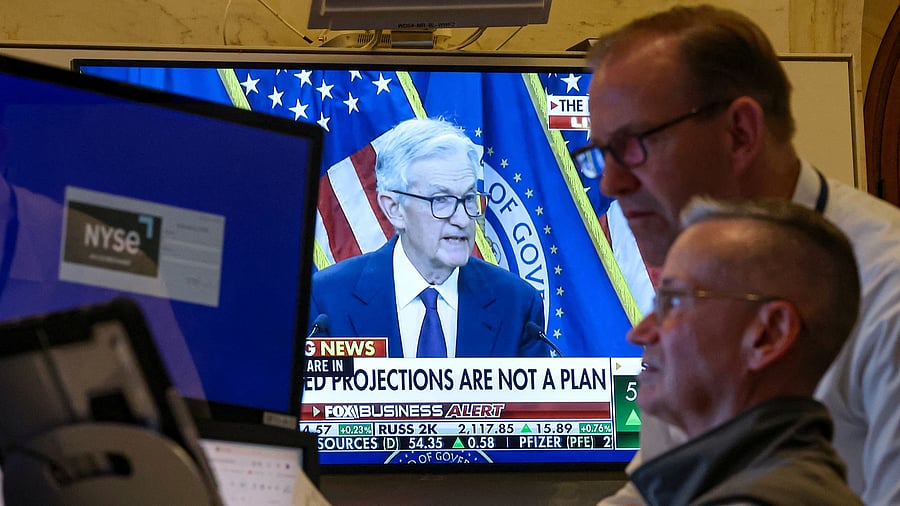
Traders work, as a screen broadcasts a news conference by US Federal Reserve Chair Jerome Powell following the Fed rate announcement, on the floor of the New York Stock Exchange in New York City, June 18, 2025.
Credit: Reuters Photo
Washington: The Federal Reserve held interest rates steady on Wednesday and policymakers signaled borrowing costs are still likely to fall this year, but slowed the overall pace of expected future rate cuts in the face of estimated higher inflation flowing from the Trump administration's tariff plans.
In new economic projections, policymakers sketched a modestly stagflationary picture of the US economy, with economic growth slowing to 1.4 per cent this year, unemployment rising to 4.5 per cent by the end of this year, and inflation finishing 2025 at 3 per cent, well above the current level.
While policymakers still anticipate cutting rates by half a percentage point this year, as they projected in March and December, they slightly slowed the pace from there to a single quarter-percentage-point cut in each of 2026 and 2027 in a protracted fight to return inflation to the central bank's 2 per cent target.
Under the new projections, inflation remains elevated at 2.4 per cent through 2026 before falling to 2.1 per cent in 2027 amid largely stable unemployment.
"Uncertainty about the economic outlook has diminished but remains elevated," the Fed said in its latest policy statement, a modification of language used in May, at a more turbulent moment in the trade debate, when it said that the risk of both higher inflation and higher unemployment had risen.
Those outcomes were embedded in the new projections, the Fed's latest thinking about how President Donald Trump's suite of economic policies is expected to shape the economy this year.
The 1.4 per cent growth in output this year compares to the 1.7 per cent rate seen in the last round of projections in March, and the 4.5 per cent unemployment rate expected at the end of the year is up from the 4.4 per cent projected in March. The rate in May was 4.2 per cent.
So far, however, "the unemployment rate remains low, and labor market conditions remain solid," the Fed said in its policy statement, which was approved unanimously.
It did not mention the sudden outbreak of hostilities between Israel and Iran and the risk that conflict posed to global oil or other markets. US stock indexes held on to modest gains after the release of the policy statement and projections, while the 10-year Treasury yield remained slightly lower. Interest rat future prices continued to suggest the Fed's September 16-17 meeting as the most likely point for the next rate cut.
"For the time being we are well positioned to wait to learn more about the likely course of the economy before considering any adjustments to our policy stance,” Fed Chair Jerome Powell told reporters at his press conference after the meeting. The Fed, he added, is set up to "react" to incoming information.
"Barring any surprises at the presser, the June FOMC looks set to be a 'placeholder' meeting, where Powell Co continue to sit on the sidelines, awaiting further clarity on how the economy evolves, and how the balance of risks to each side of the dual mandate is evolving," said Michael Brown, senior research strategist at Pepperstone, an investment firm.
Impact of tariffs
The rate projections from Fed officials for this year at least are in line with recent market expectations for a quarter-percentage-point rate reduction as soon as the September meeting. The central bank continues to ignore Trump's call for immediate rate cuts, a move Fed officials feel would be counter to their effort to ensure inflation returns to their 2 per cent target until key tariff changes are finalized and their effects are better understood. As Fed officials were meeting on Wednesday, Trump called Powell "stupid" and said the policy rate should be slashed in half, the type of move usually reserved for severe economic emergencies. The president also mused about installing himself as Fed chief.
The Fed's current policy rate was set in the current 4.25 per cent-4.50 per cent range in December, and policymakers have been reluctant to commit to a timeline for further cuts given the volatility of US trade policy, and the difficulty of estimating how the burden of higher import taxes will be spread among consumers, importers, and producing nations.